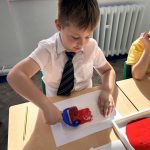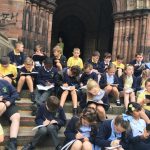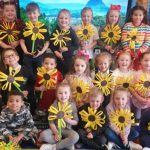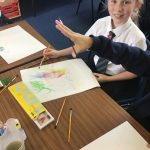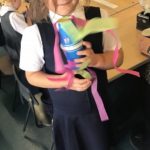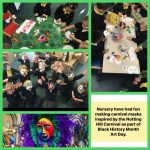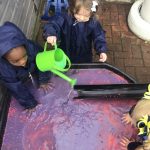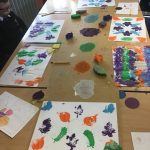Intent of our Art curriculum
The purpose of Art and Design education is to give pupils the skills, concepts and knowledge necessary for them to express their responses to ideas and experiences in a visual or tactile form. It fires their imagination and is a fundamental means of personal expression. While it is essentially a practical subject, art should provide opportunities for reflection and, with increasing sensitivity, pupils should acquire the ability to make informed, critical responses to their own work and that of others.
There is great pleasure to be derived from Art and Design and, through deeper understanding; pupils can gain access to cultural richness and diversity. The appreciation and enjoyment of the visual arts enriches all our lives.
At Westvale Primary School it is our intent that through the teaching of Art, the children in our school:
- Find enjoyment in art and creativity.
- Hold a positive self-image and confidence.
- Discover a sense of purpose and fulfilment in artistic expression.
- Appreciate a wide range of artists and art works.
- Experiment with a range of media.
- Use a range of materials and techniques competently.
- Develop their observation and description skills.
- Express ideas and feelings through creative work and in both two and three dimensions.
- Value and respect their work and the work of others.
- Discuss their work using appropriate vocabulary.
Implementation of our Art curriculum
Early Years Foundation Stage (EYFS)
Working within the EYFS 2021 framework, pupils are given the opportunity to explore texture, colour, shape, form and space. They develop their imagination and creativity and begin to investigate the qualities of materials and processes. They begin to use colour and shape to express themselves. They investigate the use of pattern and texture to represent ideas or emotions. Planning and activities through the Kapow scheme of work and other activities in the EYFS enables children to reach the following Early Learning Goal Statements which are related to Art:
Early Learning Goal 2 – Speaking
- Express their ideas and feelings about their experiences using full sentences, including the use of past, present and future tenses and making use of conjunctions, with modelling and support from the teacher.
Early Learning Goal 7 – Fine Motor Skills
- Hold a pencil effectively…..using the tripod grip in almost all cases.
- Use a range of small tools, including scissors, paint brushes and cutlery.
- Begin to show accuracy and care when drawing.
Early Learning Goal 16 – Creating and Materials
- Safely use and explore a variety of materials, tools and techniques, experimenting with colour, design, texture, form and function.
Key Stage 1
The National Curriculum prescribes that at Key Stage 1 pupils should be taught:
- To use a range of materials creatively to design and make products.
- To use drawing, painting and sculpture to develop their imagination and share their ideas and experiences.
- To develop a wide range of art and design techniques using colour, pattern, texture, line, shape, form and space.
- About the work of a range of artists, craft makers and designers, describing the differences and similarities between different practices and disciplines, and making links to their own work.
At Westvale, Key Stage 1 pupils develop their skills from EYFS through increasing their knowledge and understanding of materials and techniques, environments and their own identity and experiences. The Kapow scheme of work from EYFS Reception, feeds into the objectives in the Year 1 Kapow scheme of work by teaching prerequisite and foundational knowledge required.
At this stage pupils use colour, shape, pattern and texture to express their emotions and ideas.
They begin to ask questions and learn about other artists and art from a variety of cultures. They explore how the art was made, what it was made from and their thoughts and feelings regarding each piece.
Key Stage 2
The National Curriculum prescribes that at Key Stage 2 pupils should be taught:
- To develop their techniques, including their control and use of material, with creativity, experimentation and an increasing awareness of different kinds of art, craft and design.
- To create sketch books to record their observations and use them to review and revisit ideas.
- To improve their mastery of art and design techniques, including drawing, painting and sculpture, with a range of materials.
- About great artists, architects and designers in history.
At Westvale, Key Stage 2 pupils develop their creativity further by increasing their knowledge, skills and understanding of materials and processes. The Kapow scheme of work from Key Stage 1, feeds into the objectives the lower KS2 Kapow scheme of work by teaching prerequisite and foundational knowledge required.
Pupils’ experiences at this stage enable them to understand the diverse functions of art in the wider world.
Pupils learn to improve their use of tools and become confident in using a variety of techniques.
Pupils increase their awareness of the purposes of art from historical periods and begin to ask themselves about the purpose, creation, materials and significance of a variety of art works.
Planning
At Westvale, our the spine of our planning is taken from KAPOW and this is adapted to meet the needs of the community, cohorts and individual children.
Sketchbooks
Upon entering year 1, each pupil receives their own sketchbook which they use to complete the scheme of work, conduct artist studies and practice techniques learnt both from the scheme of work and from art enhancements offered both by the school and from external sources arranged through the school. Sketchbooks follow children through each year group to enable pupils to know and remember more and to see their own progression of skills acquired. Each new unit of work is clearly demarcated in the sketchbooks with a knowledge organiser corresponding to the unit of work. Children’s art in their sketchbooks is their own therefore Teachers do not write over their art work. Feedback is placed onto a post-it note and stuck to the child’s piece of work.
Displays
The school promotes the displaying of art work in classrooms and around the school. It can influence how children feel about their environment, convey standards and promote high expectations. We use displays to celebrate achievement and support teaching and learning.
Classroom displays showcase learning and are built upon weekly in order for children to be able to retrieve previous learning and make links. Class artists are displayed either in the classrooms or in a nearby corridor.
Inclusion
All our children have access to the art curriculum, regardless of their ability, gender, physical disability or their social, cultural or ethnic background. Where possible, provision is made to support individuals or groups of SEND children or those with a disability so that they can participate effectively in Art lessons. All children are encouraged to achieve as high standard as possible. Children working below should be identified and adaptations made in subsequent lessons to ensure progress is made. Children working at greater depth should be identified and communicated to the Art Lead to advise of challenges and deeper learning.
Assessment
Assessment should be carried out formatively before and during lessons in the form of quizzes and questioning. Feedback may be given to pupils both verbally and/or written on post-it notes on the relevant piece of work. Summative assessment should be carried out at the end of each unit of work. Assessment sheets are to be stuck into the back of children’s sketchbooks. The Class Teacher will highlight whether each pupil has met the objectives or are greater depth. The Art Lead is responsible for monitoring assessments at the back of sketchbooks and gathering data to determine the percentage of pupils not on track and at greater depth. In EYFS, art is assessed using Tapestry against the Development Matters statements and Early Learning Goals.
Impact of our Art curriculum
The intended impact of the Art Curriculum is that the majority of children in each year group are working at or above the expected level for their age.
In addition, it is the intended impact that the children:
- are inspired by the Art curriculum and want to learn more.
- show the progression in their skills, knowledge and understanding in the work in their sketchbooks.
- can discuss their learning and remember what they have learnt.
- can identify some great artists and talk about the impact that their work has had on the world and their own work.



